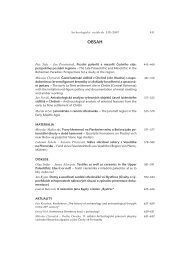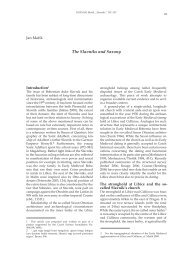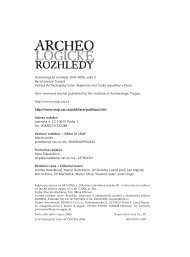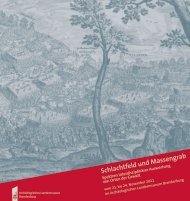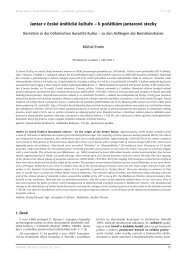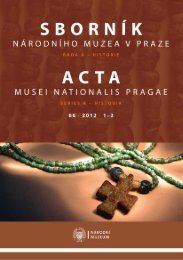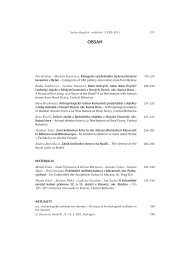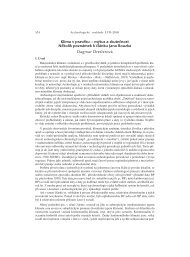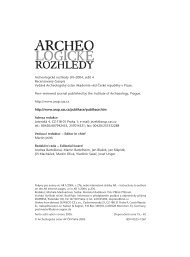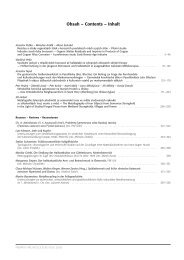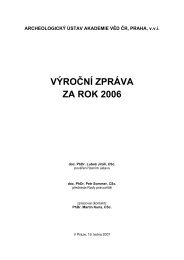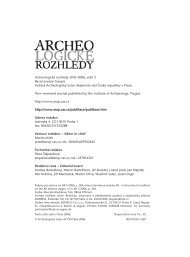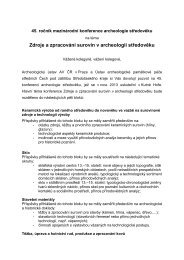Archeologické rozhledy 2009 - Archeologický ústav AV ČR
Archeologické rozhledy 2009 - Archeologický ústav AV ČR
Archeologické rozhledy 2009 - Archeologický ústav AV ČR
Create successful ePaper yourself
Turn your PDF publications into a flip-book with our unique Google optimized e-Paper software.
28KVùTINA –KVùTINOVÁ –¤ÍDK¯: V˘znam her v archaick˘ch spoleãnostech …Řídký, J. – Daněček, D. (with contributions of Z. Sedláček, L. Smejtek, M. Kostka and R. Křivánek) v tisku: NeolithicRondels in Bohemia. In: Internationale Arbeitstagung: neolitische Kreisgrabenanlagen in Europa,Goseck.Santley, R. S. – Berman, M. J. – Alexander, R. T. 1991: The Politicization of the Mesoamerican Ballgame andits Implications for the Interpretation of the Distribution of Ballcourts in Central Mexico. In: Scarborough– Wilcox eds. 1991, 3–24.Scarborough, V. L. – Wilcox, D. R. eds. 1991: The Mesoamerican Ballgame. Tucson: University of Arizona Press.Scheffler, L. – Reynoso, R. – Inzua, V. 1985: El juego de pelota prehispanico y sus supervivencias actuales.Mexico City: Premia.Schier, W. 2005: Kalenderbau und Ritualkomplex. Archäologie in Deuschland 6, 32–35.Schier, W. – Trnka, G. 2005: Die ersten Kultbauten Mitteleuropas?. Archäologie in Deutschland 6, 20–22.Schlosser, W. 2006: Alles nur Zufall? Ein statistischer Test zur Überprüfung der Sonnenorientierung vorgeschichtlicherDenkmäler. Archäologie in Sachsen-Anhalt 4 (2007), 285–288.Soukup, V. 1994: Dějiny sociální a kulturní antropologie. Praha: Univerzita Karlova.Spinden, E. S. 1933: The place of Tajin in Totonac archaeology. American Anthropologist 35, 225–270.Stäuble, H. 2002: From the air and on the ground: two aspects of the same archaeology? Round and linearditch systems in North-Western Saxony. <strong>Archeologické</strong> <strong>rozhledy</strong> 54, 301–313.Taladoire, E. 2000: El juego de pelota mesoamericano. Origen y desarrollo. Arqueología mexicana 44, 20–27.Tirpák, J. 2005: Výsledky geofyzikálneho merania troch pravekých rondeloch zo Slovenska. In: V. Hašek –R: Nekuda – M. Ruttkay edd., Ve službách archeologie 6. Sborník věnovaný 70. narozeninám PhDr.Dariny Bialekovej, CSc., 60. narozeninám prof. PhDr. Josefa Ungera, CSc., Brno: Muzejní a vlastivědnáspolečnost, 159–164.Trnka, G. 1991: Studien zu mittelneolitischen Kreisgrabenanlagen. Mitteilungen der Prähistorischen Kommissionder Österreichischen Akademie der Wissenschanften 26. Wien: Verlag der ÖsterreichischenAkademie der Wissenschaften.— vtisku: Die Erforschung der mittelneolithischen Kreisgrabenanlage von Kamegg im nördlichen Niederösterreich.In: Internationale Arbeitstagung: neolitische Kreisgrabenanlagen in Europa, Goseck.Turok, M. 2000: El juego de pelota en la actualidad. Arqueología mexicana 44, 20–27.Wilkerson, S. J. K. 1991: And Then They Were Sacrificed: The Ritual Ballgame of Northeastern MesoamericaThrough Time and Space. In: Scarborough – Wilcox eds. 1991, 45–72.Wright, R. 2002: Víc než nic. Logika lidského osudu. Praha: Lidové noviny.Zápotocká, M. 1984: Armringe aus Marmor und anderen Rohstoffen im jüngeren Neolithikum Böhmensund Mitteleuropas. Památky archeologické 75, 50–132.— 1998: Bestattungsritus des böhmischen Neolithikums (5500–4200 B.C.). Praha: <strong>Archeologický</strong> <strong>ústav</strong><strong>AV</strong> <strong>ČR</strong>.The importance of games in archaic societiesArchaeological study optionsThe topic of this contribution is games, which are understood to be an important social phenomenonthat has accompanied man for many ages. Based on ethnographic and historical studies, it can beclaimed that the phenomenon of playing games is a near anthropological constant. In preliteratesocieties, however, games were not just a leisure activity, but were closely linked to the spiritual sphere –either directly with religion or with the area of social interaction (prestige, authority, war, etc.).For an activity to be called a game, it has to meet certain criteria: it is organised, often alsoinstitutionalised; it is a competition in which two or more sides (the opponent can also be “luck”)compete; the playing field (court) is defined; the game has clear rules with which the players areacquainted; there are criteria in accordance with which the winner is determined; for a large groupof games, their duration is also fixed. A classification system for games was created in the 1950s inaccordance with what factor had a dominant influence on victory in a game in the relevant category.This traditional typology encompasses three groups: games of chance, strategy games and games of



